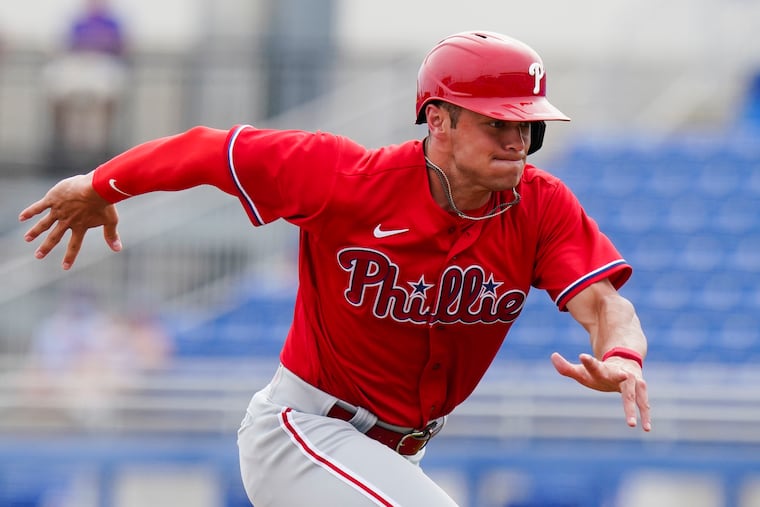The Phillies have baseball’s hottest catching prospect. What does that mean for the trade deadline? And J.T. Realmuto?
Logan O'Hoppe's emergence as one of the best-hitting catchers in the minor leagues raises a long list of questions for the Phillies ahead of the MLB trade deadline.

READING, Pa. — With two months to go before the trade deadline, the most important questions facing the Phillies are some of the same ones Logan O’Hoppe is trying to ignore.
Where does he fit? Wherever he fits, what does that mean for J.T. Realmuto? Whatever it means for Realmuto, how does that impact Rhys Hoskins? And Alec Bohm? And Bryson Stott?
One thing is clear: If O’Hoppe continues to hit the way he has over the last eight months, Dave Dombrowski will soon confront his biggest decision as team president. And the more you look at his options, the more you wonder whether the end result can be anything other than a trade that will radically transform the Phillies roster both now and in the future.
If that sounds absurd, it’s only because O’Hoppe’s meteoric rise has outpaced any ability to process its implications. After spending most of 2021 at low-Class A Jersey Shore, the 22-year-old catcher has put together an eight-month stretch that has sealed his transformation from 23rd-round draft pick to legitimate blue-chip prospect.
First came a breakout performance in the elite Arizona Fall League, where O’Hoppe drew raves from scouts while posting a .440 on-base percentage and .960 OPS with 21 walks, 15 strikeouts, and 11 extra-base hits in 100 plate appearances. Then came a weeklong stretch in double-A Reading in which he hit six home runs in six games. Now, after a monster month that has seen him hit .323/.422/.667 with 15 extra base hits and 13 walks in 109 plate appearances, O’Hoppe enters Memorial Day looking like a player who could soon run out of questions to answer at the minor league level.
At which point, the Phillies will need to start to consider the two most critical words in player development:
Now what?
Catcher is one of the few positions in baseball where a prospect can legitimately be blocked. With Realmuto under contract for three more years and $71.6 million, something clearly will need to give before O’Hoppe gets his chance.
“I look at it more like I get to learn from him,” O’Hoppe said last week. “He’s the best in the game and he’s helped me a lot and taught me a lot. The way I look at that is I get to pick his brain even more.”
It’s a nice thought, but a better one for the Phillies is figuring out how to take advantage of their surplus. There are two questions Dombrowski must ask himself between now and the Aug. 2 trade deadline. Where do we need to go from here? And, wherever that is, how do we get there?
The Phillies entered the season hoping that they’d moved beyond these sorts of existential dilemmas. In Realmuto, Bryce Harper, Kyle Schwarber, and Nick Castellanos, they had top-of-the-order bats signed through at least 2025. In Stott and Ranger Suárez, they had a couple of young, cost-controlled talents who could provide years of premium production at below-market rate. They had two top-of-the-rotation arms signed through at least 2023. The heavy lifting had been done.
Two months into the season, reality looks a lot different than it did on paper. With Stott struggling, Didi Gregorius injured, and center field a vacancy, the Phillies have three huge holes in their lineup. Suárez has looked like a guy that a playoff team would love to have as its fifth starter, but certainly not at No. 3. All of it could work with a bullpen that goes five or six deep, but the Phillies are three or four arms short of that. The daunting thing about teams like the Mets and the Dodgers isn’t their win totals but the sum of their individual parts. Go position-by-position and the disparity is clear. The Phillies are still several pieces away from that level. True contenders don’t have their holes, nor their lack of hope for filling them. They aren’t starting Bailey Falter in a game against the Mets. They probably aren’t even starting Kyle Gibson.
Enter O’Hoppe. One way or another, his emergence gives the Phillies some options for acquiring the pitching they so desperately need, either before the trade deadline or in the offseason. The tough part is figuring out who the trade chip should be. It’s a fascinating dilemma, one that has the potential to impact every position on the roster. This goes well beyond the Phillies’ evaluation of O’Hoppe, or their expectations for Realmuto. Can Bohm stick defensively at third base? If not, can he hit well enough to play first? Either way, what is Hoskins’ future? If the Phillies don’t envision re-signing him after next season, can they get value for him in a trade? How does Realmuto’s ability to play first base factor into the Bohm-Hoskins calculus? And does it even matter, since his bat would be below average there?
It all comes back to one fundamental question: Can O’Hoppe hit major-league pitching? There’s a plausible scenario in which the Phillies remain mired below .500 and it makes sense to dangle Realmuto on the trade market. If they can net a couple of young arms who upgrade what they have, it might be worth the risk of finding out if O’Hoppe is legit. Otherwise, the Phillies should operate as if the iron is as hot as it will ever be. Whatever they decide, there will be plenty of risk. But the first two months of 2022 have made one thing clear: They need a big hit, and that requires a big swing.